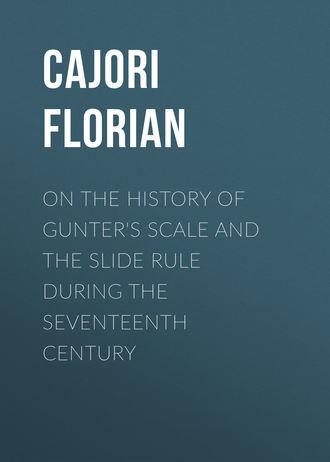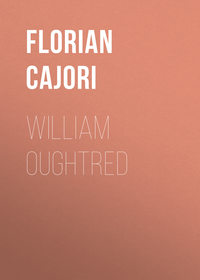 полная версия
полная версияOn the History of Gunter's Scale and the Slide Rule during the Seventeenth Century
There is no date. There follows the diagram of a second circular slide rule, with the inscription within the innermost ring: Typus proiectionis Annuli adaucti vt in Conslusione Lybri praelo commissi, Anno 1630 promisi. There are numerous drawings in the Grammelogia, all of which, excepting the drawings of slide rules on the engraved title-pages of Grammelogia IV and V, were printed upon separate pieces of paper and then inserted by hand into the vacant spaces on the printed pages reserved for them. Some drawings are missing, so that the Bodleian Grammelogia IV differs in this respect slightly from the copy in the British Museum and from the British Museum copy of Grammelogia V.
21
Epistle, p. (8).
22
Aubrey, op. cit., Vol. II., p. 111.
23
Rigaud, Correspondence of Scientific Men during the 17th Century, Vol. I, Oxford, 1841, p. 11.
24
Dictionary of National Biography, Art. “Delamain, Richard.” See also Rev. Charles J. Robinson, Taylors’ School, from A.D. 1562 to 1874, Vol. I, 1882, p. 151; Journal of the House of Commons, Vol. IV., p. 197b; Sixth Report of the Royal Commission on Historical Manuscripts, Part I, Report and Appendix, London, 1877. In this Appendix, p. 82, we read the following:
Oct. 22 [1645] Petition of Sarah Delamain, relict of Richard Delamain. Petitioner’s husband was servant to the King, and one of His Majesty’s engineers for the fortification of the kingdom, and his tutor in mathematical arts; but upon the breaking out of the war he deserted the Court, and was called by the State to several employments, in fortifying the towns of Northampton, Newport, and Abingdon; and was also abroad with the armies as Quartermaster-General of the Foot, and therein died. Petitioner is left a disconsolate widow with ten children, the four least of whom are now afflicted with sickness, and petitioner has nothing left to support them. There are several considerable sums of money due to the petitioner, as well from the King as the State. Prays that she may have some relief amongst other widows. See L. J., VII. 6. 657.
25
Anthony Wood, Athenae Oxonienses (Edition Bliss) Vol. IV., London, 1820, p. 34.
26
The New Artificial Gauging Line or Rod: together with rules concerning the use thereof: Invented and written by WILLIAM OUGHTRED, etc., London, 1633. The copy we have seen is in the Bodleian Library, Oxford. The book is small sized and has 40 pages.
27
Oughtred, op. cit., p. 11.
28
S. J. Rigaud, Correspondence of Scientific Men of the 17th Century, Oxford, Vol. I, 1841, p. 17.
29
Rigaud, loc. cit., p. 22.
30
Rigaud, loc. cit., pp. 30, 31.
31
Oughtred, An Addition vnto the Vse of the Instrument called the Circles of Proportion, London, 1633, p. 63.
32
F. Cajori, History of the Slide Rule, New York, 1909, pp. 16-22, Addenda, pp. vi-ix.
33
W. Leybourn, op. cit., 1673, Preface, and pp. 128-29.
34
Cajori op. cit., Addenda, p. ix.
35
William Leybourn, op. cit., 1673, p. 35.
36
See Cajori, op. cit., pp. 20, 28, Addenda, p. ix.
37
See F. Cajori, “A Note on the History of the Slide Rule,” Bibliotheca mathematica, 3 F., Vol. 10, pp. 161-163.
38
John Atkinson, op. cit., 1694, p. 204.
39
Probably the oldest slide rule now in existence is owned by St. John’s College, Oxford, and is in the form of a brass disc, 1 ft. 6 in. in diameter. It was exhibited along with other instruments in May, 1919. According to the Catalogue of a Loan Exhibition of Early Scientific Instruments in Oxford, opened May 16, 1919, the instrument is inscribed with the name of the maker (“Elias Allen fecit”) and with the name of the donor, Georgius Barkham. It is dated 1635, which is only three years after the first publication of Oughtred’s description of his circular slide rule. It is stated in the Catalogue: “Unfortunately all the movable parts but the base-plate and a couple of thumb-screws are missing. The face of the instrument is engraved with Oughtred’s Horizontal Instrument. The back is engraved with eleven Circles of Proportion as described in Arthur Haughton’s book, a copy of which was presented to St. John’s College by George Barkham, to explain the use of the instrument.” As Arthur Haughton’s Oxford edition of Oughtred’s Circles of Proportion did not appear until 1660, it would seem that the instrument was probably not presented to the College before 1660. As far as is known, the next oldest slide rule is of the year 1654, kept in the South Kensington Museum, London, and is described in Nature of March 5, 1914. It is a rectilinear rule, “of boxwood, well made, and bound together with brass at the two ends. It is of the square type, a little more than 2 ft. in length, and bears the logarithmic lines first described by Edmund Gunter. Of these, the num, sin and tan lines are arranged in pairs, identical and contiguous, one line in each pair being on the fixed part, and the other on the slide.” The instrument is inscribed, “Made by Robert Bissaker for T. W., 1654.” Nowhere else have we seen reference to Robert Bissaker. His slide rule seems to antedate the “Whites rule” mentioned above. [This foot-note was added on October 15, 1919.]


